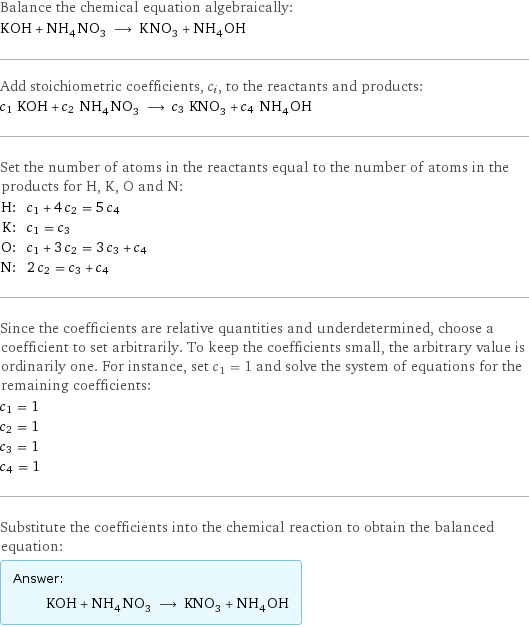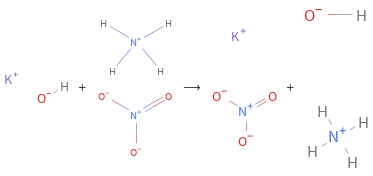Input interpretation

KOH potassium hydroxide + NH_4NO_3 ammonium nitrate ⟶ KNO_3 potassium nitrate + NH_4OH ammonium hydroxide
Balanced equation

Balance the chemical equation algebraically: KOH + NH_4NO_3 ⟶ KNO_3 + NH_4OH Add stoichiometric coefficients, c_i, to the reactants and products: c_1 KOH + c_2 NH_4NO_3 ⟶ c_3 KNO_3 + c_4 NH_4OH Set the number of atoms in the reactants equal to the number of atoms in the products for H, K, O and N: H: | c_1 + 4 c_2 = 5 c_4 K: | c_1 = c_3 O: | c_1 + 3 c_2 = 3 c_3 + c_4 N: | 2 c_2 = c_3 + c_4 Since the coefficients are relative quantities and underdetermined, choose a coefficient to set arbitrarily. To keep the coefficients small, the arbitrary value is ordinarily one. For instance, set c_1 = 1 and solve the system of equations for the remaining coefficients: c_1 = 1 c_2 = 1 c_3 = 1 c_4 = 1 Substitute the coefficients into the chemical reaction to obtain the balanced equation: Answer: | | KOH + NH_4NO_3 ⟶ KNO_3 + NH_4OH
Structures

+ ⟶ +
Names

potassium hydroxide + ammonium nitrate ⟶ potassium nitrate + ammonium hydroxide
Equilibrium constant
![Construct the equilibrium constant, K, expression for: KOH + NH_4NO_3 ⟶ KNO_3 + NH_4OH Plan: • Balance the chemical equation. • Determine the stoichiometric numbers. • Assemble the activity expression for each chemical species. • Use the activity expressions to build the equilibrium constant expression. Write the balanced chemical equation: KOH + NH_4NO_3 ⟶ KNO_3 + NH_4OH Assign stoichiometric numbers, ν_i, using the stoichiometric coefficients, c_i, from the balanced chemical equation in the following manner: ν_i = -c_i for reactants and ν_i = c_i for products: chemical species | c_i | ν_i KOH | 1 | -1 NH_4NO_3 | 1 | -1 KNO_3 | 1 | 1 NH_4OH | 1 | 1 Assemble the activity expressions accounting for the state of matter and ν_i: chemical species | c_i | ν_i | activity expression KOH | 1 | -1 | ([KOH])^(-1) NH_4NO_3 | 1 | -1 | ([NH4NO3])^(-1) KNO_3 | 1 | 1 | [KNO3] NH_4OH | 1 | 1 | [NH4OH] The equilibrium constant symbol in the concentration basis is: K_c Mulitply the activity expressions to arrive at the K_c expression: Answer: | | K_c = ([KOH])^(-1) ([NH4NO3])^(-1) [KNO3] [NH4OH] = ([KNO3] [NH4OH])/([KOH] [NH4NO3])](../image_source/6080c7a7a06f28d037c78158af12ca75.png)
Construct the equilibrium constant, K, expression for: KOH + NH_4NO_3 ⟶ KNO_3 + NH_4OH Plan: • Balance the chemical equation. • Determine the stoichiometric numbers. • Assemble the activity expression for each chemical species. • Use the activity expressions to build the equilibrium constant expression. Write the balanced chemical equation: KOH + NH_4NO_3 ⟶ KNO_3 + NH_4OH Assign stoichiometric numbers, ν_i, using the stoichiometric coefficients, c_i, from the balanced chemical equation in the following manner: ν_i = -c_i for reactants and ν_i = c_i for products: chemical species | c_i | ν_i KOH | 1 | -1 NH_4NO_3 | 1 | -1 KNO_3 | 1 | 1 NH_4OH | 1 | 1 Assemble the activity expressions accounting for the state of matter and ν_i: chemical species | c_i | ν_i | activity expression KOH | 1 | -1 | ([KOH])^(-1) NH_4NO_3 | 1 | -1 | ([NH4NO3])^(-1) KNO_3 | 1 | 1 | [KNO3] NH_4OH | 1 | 1 | [NH4OH] The equilibrium constant symbol in the concentration basis is: K_c Mulitply the activity expressions to arrive at the K_c expression: Answer: | | K_c = ([KOH])^(-1) ([NH4NO3])^(-1) [KNO3] [NH4OH] = ([KNO3] [NH4OH])/([KOH] [NH4NO3])
Rate of reaction
![Construct the rate of reaction expression for: KOH + NH_4NO_3 ⟶ KNO_3 + NH_4OH Plan: • Balance the chemical equation. • Determine the stoichiometric numbers. • Assemble the rate term for each chemical species. • Write the rate of reaction expression. Write the balanced chemical equation: KOH + NH_4NO_3 ⟶ KNO_3 + NH_4OH Assign stoichiometric numbers, ν_i, using the stoichiometric coefficients, c_i, from the balanced chemical equation in the following manner: ν_i = -c_i for reactants and ν_i = c_i for products: chemical species | c_i | ν_i KOH | 1 | -1 NH_4NO_3 | 1 | -1 KNO_3 | 1 | 1 NH_4OH | 1 | 1 The rate term for each chemical species, B_i, is 1/ν_i(Δ[B_i])/(Δt) where [B_i] is the amount concentration and t is time: chemical species | c_i | ν_i | rate term KOH | 1 | -1 | -(Δ[KOH])/(Δt) NH_4NO_3 | 1 | -1 | -(Δ[NH4NO3])/(Δt) KNO_3 | 1 | 1 | (Δ[KNO3])/(Δt) NH_4OH | 1 | 1 | (Δ[NH4OH])/(Δt) (for infinitesimal rate of change, replace Δ with d) Set the rate terms equal to each other to arrive at the rate expression: Answer: | | rate = -(Δ[KOH])/(Δt) = -(Δ[NH4NO3])/(Δt) = (Δ[KNO3])/(Δt) = (Δ[NH4OH])/(Δt) (assuming constant volume and no accumulation of intermediates or side products)](../image_source/b7b0476c58f017f7285f77ca4d3cd57b.png)
Construct the rate of reaction expression for: KOH + NH_4NO_3 ⟶ KNO_3 + NH_4OH Plan: • Balance the chemical equation. • Determine the stoichiometric numbers. • Assemble the rate term for each chemical species. • Write the rate of reaction expression. Write the balanced chemical equation: KOH + NH_4NO_3 ⟶ KNO_3 + NH_4OH Assign stoichiometric numbers, ν_i, using the stoichiometric coefficients, c_i, from the balanced chemical equation in the following manner: ν_i = -c_i for reactants and ν_i = c_i for products: chemical species | c_i | ν_i KOH | 1 | -1 NH_4NO_3 | 1 | -1 KNO_3 | 1 | 1 NH_4OH | 1 | 1 The rate term for each chemical species, B_i, is 1/ν_i(Δ[B_i])/(Δt) where [B_i] is the amount concentration and t is time: chemical species | c_i | ν_i | rate term KOH | 1 | -1 | -(Δ[KOH])/(Δt) NH_4NO_3 | 1 | -1 | -(Δ[NH4NO3])/(Δt) KNO_3 | 1 | 1 | (Δ[KNO3])/(Δt) NH_4OH | 1 | 1 | (Δ[NH4OH])/(Δt) (for infinitesimal rate of change, replace Δ with d) Set the rate terms equal to each other to arrive at the rate expression: Answer: | | rate = -(Δ[KOH])/(Δt) = -(Δ[NH4NO3])/(Δt) = (Δ[KNO3])/(Δt) = (Δ[NH4OH])/(Δt) (assuming constant volume and no accumulation of intermediates or side products)
Chemical names and formulas

| potassium hydroxide | ammonium nitrate | potassium nitrate | ammonium hydroxide formula | KOH | NH_4NO_3 | KNO_3 | NH_4OH Hill formula | HKO | H_4N_2O_3 | KNO_3 | H_5NO name | potassium hydroxide | ammonium nitrate | potassium nitrate | ammonium hydroxide
Substance properties

| potassium hydroxide | ammonium nitrate | potassium nitrate | ammonium hydroxide molar mass | 56.105 g/mol | 80.04 g/mol | 101.1 g/mol | 35.046 g/mol phase | solid (at STP) | solid (at STP) | solid (at STP) | aqueous (at STP) melting point | 406 °C | 169 °C | 334 °C | -57.5 °C boiling point | 1327 °C | 210 °C | | 36 °C density | 2.044 g/cm^3 | 1.73 g/cm^3 | | 0.9 g/cm^3 solubility in water | soluble | | soluble | very soluble dynamic viscosity | 0.001 Pa s (at 550 °C) | | | odor | | odorless | odorless |
Units
